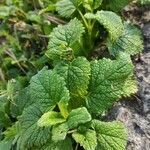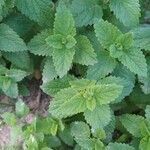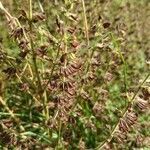Rhizomatous, lemon-scented herb with branched puberulent stems ascending to c. 60 cm. Lvs and bracts petiolate. Lamina 2-8.5 × 1-7 cm, elliptic to broad-ovate, hairy, sometimes only sparsely hairy above, prominently crenate-serrate; base ± truncate in larger lower lvs, cuneate in upper smaller lvs and bracts. Verticels generally 3-10-flowered. Calyx c. 8 mm long; nerves prominent, with long, white, pilose hairs; upper teeth broad-triangular, aristate; lower narrow-triangular, aristate. Corolla 12-15 mm long, white; lobes hairy outside. Nutlets 1.7-2 mm long, almost black.
A vigorous herb up to 0.5-1.2 m high. It spreads to 30-45 cm wide. Plants keep growing from year to year. The stems are erect, square shaped, branching and hairy. The leaves are produced opposite one another and are oval. The leaves are wrinkled and toothed at the edge. They are 7 cm long. The leaves have a lemon smell when crushed. The leaf stalk is long. The flowers are small and whitish yellow. These are produced on long loose clusters. The flowers are in the axils of leaves. The fruit is made up of 4 oval nutlets.
Lemon-scented perennial, 4–8 dm; lvs long-petioled, ovate or deltoid-ovate, coarsely crenate, broadly obtuse to truncate at base, the main ones 4–7 cm, those of the branches much smaller and often cuneate at base; verticils few-fld, axillary to foliage lvs; pedicels 3–5 mm; cal 7–9 mm, the lips two-thirds as long as the tube; cor pale yellow, becoming white or pinkish, 8–15 mm, the lips 3 mm; 2n=32. Native of w. Asia, escaped from cult. and established in much of our range. June–Aug.












